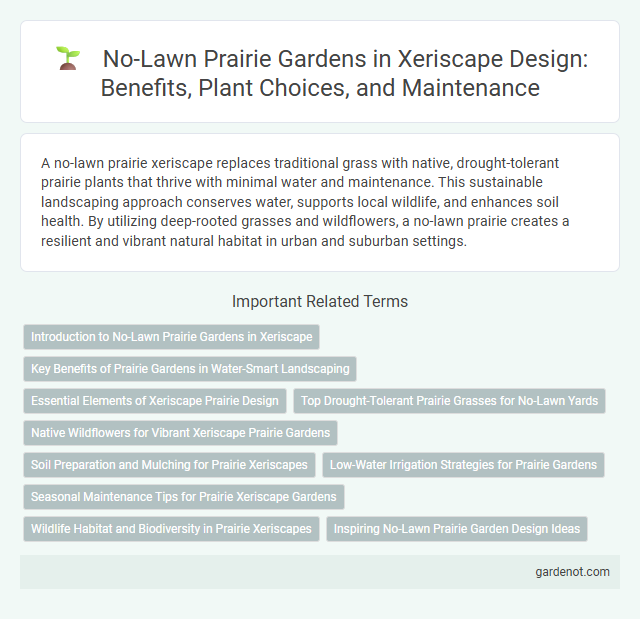A no-lawn prairie xeriscape replaces traditional grass with native, drought-tolerant prairie plants that thrive with minimal water and maintenance. This sustainable landscaping approach conserves water, supports local wildlife, and enhances soil health. By utilizing deep-rooted grasses and wildflowers, a no-lawn prairie creates a resilient and vibrant natural habitat in urban and suburban settings.
Introduction to No-Lawn Prairie Gardens in Xeriscape
No-lawn prairie gardens in xeriscape design mimic native prairie ecosystems, using drought-tolerant grasses and wildflowers to conserve water and reduce maintenance. These gardens support local biodiversity by providing habitat for pollinators like bees and butterflies while enhancing soil health with deep-rooted plants. Implementing no-lawn prairie landscapes significantly decreases irrigation needs compared to traditional turf grass, promoting sustainable gardening in arid and semi-arid regions.
Key Benefits of Prairie Gardens in Water-Smart Landscaping
Prairie gardens significantly reduce water consumption by utilizing deep-rooted native grasses and wildflowers adapted to local climates, promoting drought resilience. These no-lawn landscapes improve soil health and support biodiversity by providing habitat for pollinators and beneficial insects. Incorporating prairie gardens in xeriscaping minimizes irrigation needs, lowers maintenance costs, and enhances ecosystem sustainability in water-sensitive regions.
Essential Elements of Xeriscape Prairie Design
No-lawn prairie xeriscape design incorporates native drought-tolerant grasses, pollinator-friendly wildflowers, and deep-rooted plants for efficient water absorption and soil stabilization. Strategic plant placement and mulching reduce evaporation while enhancing biodiversity and habitat resilience. These elements create a sustainable, low-maintenance landscape that conserves water and supports local ecosystems.
Top Drought-Tolerant Prairie Grasses for No-Lawn Yards
Top drought-tolerant prairie grasses like Little Bluestem (Schizachyrium scoparium), Purple Needlegrass (Stipa pulchra), and Big Bluestem (Andropogon gerardii) are ideal for no-lawn xeriscape yards. These native grasses thrive in low-water conditions, require minimal maintenance, and support local wildlife. Incorporating these species reduces water usage while enhancing soil health and biodiversity in dry climates.
Native Wildflowers for Vibrant Xeriscape Prairie Gardens
Native wildflowers such as coneflowers, black-eyed Susans, and purple asters thrive in no-lawn prairie xeriscape gardens, providing vibrant color while conserving water. These drought-tolerant species support local pollinators and require minimal irrigation once established. Incorporating native wildflowers enhances biodiversity and creates a sustainable, low-maintenance landscape that reduces water usage significantly.
Soil Preparation and Mulching for Prairie Xeriscapes
Soil preparation for no-lawn prairie xeriscapes involves deep tilling to improve aeration and incorporating organic matter to enhance water retention and nutrient availability. Mulching with native straw or wood chips conserves moisture, suppresses weeds, and stabilizes soil temperature, promoting healthy root development. Proper soil conditioning combined with strategic mulching ensures drought-resistant, low-maintenance prairie landscapes.
Low-Water Irrigation Strategies for Prairie Gardens
No-lawn prairies utilize low-water irrigation strategies such as drip irrigation and deep watering techniques to efficiently hydrate native grasses and drought-tolerant plants, minimizing water waste. These systems support root development by delivering moisture directly to the soil, reducing evaporation and runoff compared to traditional sprinklers. Incorporating mulch and selecting xeric-adapted prairie species further enhances water conservation in sustainable prairie garden designs.
Seasonal Maintenance Tips for Prairie Xeriscape Gardens
Prairie xeriscape gardens thrive with seasonal maintenance that includes periodic mowing to mimic natural prairie burns, promoting native plant health and reducing invasive weeds. Spring is ideal for removing dead foliage and applying mulch to retain moisture, while fall preparation involves cutting back perennials and checking soil moisture to ensure plant resilience through winter. Proper seasonal care maximizes water efficiency and sustains biodiversity in no-lawn prairie landscapes.
Wildlife Habitat and Biodiversity in Prairie Xeriscapes
No-lawn prairie xeriscapes create rich wildlife habitat by incorporating native grasses and wildflowers that support pollinators such as bees, butterflies, and birds. These diverse plant communities enhance biodiversity by providing food sources, nesting sites, and shelter for numerous species adapted to local climates and soil conditions. Implementing prairie xeriscapes reduces water usage while promoting ecological balance and resilience in urban and suburban landscapes.
Inspiring No-Lawn Prairie Garden Design Ideas
Creating a no-lawn prairie garden emphasizes native grasses, wildflowers, and drought-tolerant plants that enhance biodiversity while conserving water. Incorporating species like Little Bluestem, Purple Coneflower, and Black-eyed Susan provides vibrant seasonal color and supports pollinator habitats. Strategic layering and naturalistic design maximize aesthetic appeal and ecological function, making no-lawn prairie gardens an inspiring choice for sustainable landscaping.
No-lawn prairie Infographic

 gardenot.com
gardenot.com